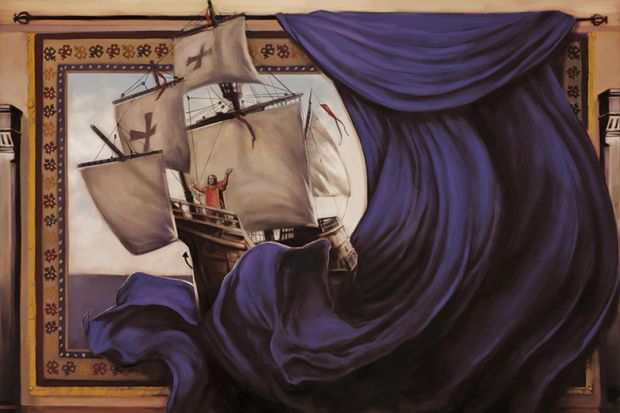Art is trouble. It stimulates passions – aesthetes’ delight, lovers’ arousal, collectors’ envy, partisans’ pride. Resentment, anger and hatred are ineluctable hazards.
Maybe on your campus you have memorials of morally dodgy founders and benefactors, or portraits of sometime heroes whom shifting demographics have transformed into villains. Perhaps a statue of a dead white male – admirable, abominable or indifferent as your prejudice takes you – induces indignation from exceptionally sensitive or unduly touchy onlookers. Or, like my own institution, the University of Notre Dame, you may have a controversial set of late 19th-century murals mawkishly romanticising Columbus.
Protesters pester you. Divisiveness threatens. How do you contain outrage, balance conflicting sensibilities, avert adverse publicity and assuage donors? Notre Dame’s president, John Jenkins, incurred acrimony by decreeing in January that our murals would be concealed behind tastefully “woven material” – like a Victorian matron’s potentially offensive piano legs – and occasionally exposed for exhibition. Was that wise? Here’s a seven-point guide for perplexed top brass.
- Be conspicuously consensual. Consult representatives of every potentially offended constituency and outside experts of impeccable diversity and credentials. Publish the advice. Issue no ukase and impose no hasty decision: deferential delay is better than precipitate provocation.
- Don’t yield to ignorance. If, for example, petitioners, like some of those who have reviled our murals at Notre Dame, cite the Black Legend of Spanish malignity, or tell you that Columbus committed genocide or caused any of the iniquities of US history, or was so vicious as to be unworthy of commemoration, put them right: your job is to educate the ignorant and uphold truth. Moral discrimination is good, but not if founded on falsehood.
- Don’t evade the truth about your own university. All old institutions have taints of slavery, racism, imperialism, patriarchy, bellicosity and almost every other current cause of revulsion. Admit it. Expose the evidence with candour and courage. Embrace any shame you feel. Cover-ups won’t make the past purer or the future better informed. You can hate or dishonour Colston or Columbus, Codrington or Rhodes, Jefferson or the Unknown Soldier without concealing their memorials. You gain nothing, except the complacency of the ostrich, self-blinded to danger, by toppling their effigies or obliterating their names: they remain part of your story.
- Encourage dispassionate, informed study of the questions the art raises. Found, if you can – as Notre Dame’s president proposes – a centre for relevant research and teaching. But don’t exploit the availability of reproductions as a reason for smothering the originals: rather, use the resources of the study centre to enhance gallery talks and objective study aids. If you feel you have to post exculpatory “contextualisations”, write them unsquirmingly: practise custodianship, not censoriousness.
- Don’t surrender to partiality. Acknowledge genuine differences of perception. For instance, sincere but – to my eye – deluded complainants at Notre Dame think our murals demean the native Tainos they depict. But that was not the intention of the painter, Luigi Gregori, or the patrons in the 1880s. On the contrary, their purpose was to display the New World as morally superior – uncorrupted by Old World ways, more receptive to Christ than the former homelands of the poor immigrants whom the university served. Gregori painted natives with no interest in historical accuracy, but with an artist’s insight. He shared Columbus’ own conflictive perceptions of them as vulnerable but innocent. He made them look awestruck at the cross; like St Francis, they are dependent on God in their nakedness; like God, they are compassionate – sympathising with Columbus when enemies arraign and chain him for his crimes. In the scene of their reception at court, Gregori’s natives evince the dignity of natural nobility. The ugliness attributed to the images is in the eye of the beholder. The duty of the educator is to encourage a revealing shift of perspective.
- Honour the victims of historic marginalisation and unstintingly favour their descendants, whom the consequences of exploitation and expropriation may still afflict. But don’t marginalise any of the rest of us, either by ignoring our opinions or undervaluing our feelings. Notre Dame’s Columbus murals attract deep emotional investment from Catholics, whose forebears were a marginalised minority when Gregori was at work. To Hispanics, like me, the paintings may be venerable relics of the era when Columbus and other servants of the Spanish monarchy were vaunted as adoptive American heroes – or, at least, assimilable misfits. At the time, the Spanish heritage of much of the US was beginning to struggle for recognition. The struggle is not over. We greasers and dagos need the memorials of our past.
- Finally, augment diversity. If some constituents, for instance, dislike the art of the 1880s, commission something new to reflect today’s values or tics. If Native Americans feel ill represented by existing work on campus, bring artists in to create images that right the imbalance and show natives’ ancestors in their greatness and glory. If Gregori, say, seems to you to have been too kind to Columbus, offer a rival perspective in paintings that display what the president of Notre Dame has called “the dark side” of European intrusions in the western hemisphere. For Notre Dame, a work celebrating the displaced native denizens of the land we now occupy, rather than obscuring Columbus, might be a better way into the dark side of our history.
Felipe Fernández-Armesto is William P. Reynolds professor of history at the University of Notre Dame.
后记
Print headline: Navigate the seas of rage




